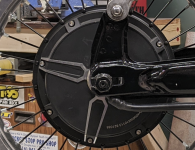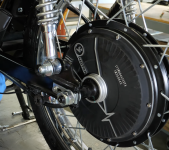Okay, so similar to a bicycle wheel, it's the tension created by pinching the dropout faces against the axle flats.
Based on your description of the math and manual statements, I'm not sure if you're describing the same thing that pinching torque plates / dropouts do.
They clamp onto the axle flats themselves, preventing the axle from spinning or moving in any direction, without any other axle hardware at all required. (no axle nuts, etc).
Bicycle dropouts get their inboard faces pressed against the axle *shoulders* of bicycle wheels by the axle nuts. This prevents the axle from shifting around in the dropouts, but is not intended to prevent it from rotating (because that in itself is not important to a bicycle or motorcycle wheel (with two exceptions, an IGH or a brake hub, if those don't have integral torque arms) , while it *is VERY* important to a typically-designed hubmotor wheel with axle flats and no integral torque arm)
They're two completely different directions of force and methods of attachment, designed to do different things.
So...I'm suggesting you not depend on the axle nut and inboard dropout faces, and use the pinching dropouts, which you can find examples of in the Torque Arm Picture thread, or at the present end of my SB Cruiser trike thread, etc. You can still use your nuts if you prefer, but if the pinching part is designed and installed correctly, it'll be secure without them.

I was more concerned about the translational motion that I'm imagining happens whenever the vehicle accelerates and decelerates due to inertia. For example, when the vehicle is at rest and the rear wheel starts moving forward, isn't there a translational force on the axle that needs to be transferred to push the rest of the vehicle forward?
Yes, and that is what the torque arm does--transfers the motor's rotation to the frame via the tiny itsy bitsy axle flat surface area that contacts the torque arm's interface.
The pinching torque plate or dropout does the same job, and can be designed with a much larger surface area in contact with that tiny axle flat area because it can replace the nut (and potentially the entire dropout of the frame, so that *all* of the axle length can be clamped to if you find that necessary for the torque a particular system produces).





